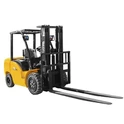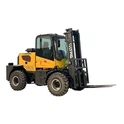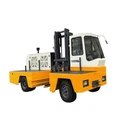With the growing adoption of green logistics and sustainable development, electric forklifts, with their zero emissions, low noise, and low maintenance costs, have become the preferred handling equipment for modern warehouses, distribution centers, and some construction sites. However, a practical question arises: Can electric forklifts operate safely in sudden rainy conditions or when short-term operations are required in open areas?
This is a common concern for many business users when selecting and managing equipment. This article systematically addresses this question from multiple perspectives, including the equipment's waterproofing capabilities, potential risks, applicable conditions, and safety recommendations. This will help you make informed decisions, standardize operations, and ensure operational safety and equipment lifespan.
I. Electric Forklift Waterproofing: How are Key Components Protected?
Although electric forklifts are electrically powered, they are not designed to be completely water-resistant. Mainstream brands have implemented multiple sealing and protective measures in key areas to meet diverse operational needs.
1. Protection Mechanisms for Core Components
Battery System: Power batteries are typically installed in a sealed battery compartment with a rubber seal on the compartment cover to prevent rainwater intrusion. However, the terminal area should still be protected from direct rain.
Electrical Control System: Controllers, contactors, and other electronic components are often enclosed in waterproof housings and certified for IP (Ingress Protection).
Drive Motor: AC motors inherently have a high IP rating, offering dust and water resistance.
2. IP Rating is a Key Parameter
Common Configurations:
IPX4: Withstands daily rainfall and is suitable for short-term outdoor operations.
IPX5 and above: Supports high-pressure water washdowns and is commonly found in heavy-duty outdoor forklifts.
3. Design Differences Between Indoor and Outdoor Forklifts
Indoor-Specific: Focuses on lightweighting and energy efficiency, with a lower IP rating (e.g., IP20–IP43) and is not recommended for exposure to rain.
Outdoor-Specific: Designed for outdoor environments, features enhanced overall sealing and often comes with a rain cover and enclosed cab, making it suitable for temporary rainy operations.

II. Potential Risks of Driving in the Rain: These Hidden Dangers Should Not Be Ignored
Even with a certain degree of waterproofing, operating an electric forklift in the rain still presents multiple risks that require careful attention.
1. Risk of Electrical System Failure
Rainwater may seep into the control box or junction box through gaps, causing short circuits, leakage, or system alarms.
In severe cases, this may trigger the automatic power-off protection of the Battery Management System (BMS), interrupting operations.
2. Reduced Traction and Reduced Maneuverability
Wet surfaces significantly increase the risk of skidding and sliding, especially when turning or driving on slopes.
Breaking distances are increased, reaction times are delayed, and collisions can occur.
3. Limited Visibility
Rainwater adheres to the windshield or the operator's helmet visor, reducing visibility.
Low light at night or on rainy days further complicates judgment.
4. Long-term Moisture Exposure Leads to Component Corrosion
While short-term exposure to rain may not immediately damage the equipment, long-term exposure to moisture, such as cable connectors, metal brackets, and sensor interfaces, can lead to oxidation and corrosion, impacting equipment reliability and service life.
III. When can electric forklifts be used? - Clarifying the boundaries of "acceptable" conditions
Not all rainy days require a shutdown. Under the following conditions, electric forklifts with appropriate protection can be used for temporary, short-term, low-risk outdoor operations:
✅ The vehicle must have an IPX4 or higher protection rating and be a model marked by the manufacturer as suitable for outdoor use.
✅ The surface must be hardened (e.g., cement, asphalt) without significant standing water or mud.
✅ The rainfall must be light to moderate, not torrential or sustained.
✅ The operation duration must be short (recommended to be no more than 1–2 hours).
✅ The vehicle must be equipped with a rainproof system, such as the original cab, a roof, or a temporary awning.
✅ The operator must wear rainproof gear and maintain good visibility.
Note: Even if the above conditions are met, exposure time should be minimized, and the equipment should be checked promptly after the rain stops.
IV. Safety Recommendations: Five Best Practices for Rainy Day Operations
To minimize risks, the following operating procedures are recommended:
1. Pre-operation Inspection.
Confirm that the seals on the battery compartment cover and electrical control box are intact and free of loose or deteriorating signs.
Check that all cable connections are securely fastened and free of exposed or damaged cables.
2. Avoid driving through water.
Do not drive into areas with accumulated water (water depths exceeding 10 cm pose a risk of flooding).
Route around low-lying areas to prevent soaking of chassis electrical components.
3. Control operating time.
Do not operate continuously for extended periods in rainy weather. It is recommended to shut down the machine for inspection after operation and allow the equipment to dry before resuming operation.
4. Strengthen operator training.
Training should cover areas such as identifying rainy weather risks, low-grip road driving techniques, and emergency shutdown procedures.
Emphasis on "safety first" is crucial, and risky operations are prohibited.
5. Install protective equipment.
For applications requiring frequent outdoor work, it is recommended to select a vehicle with an enclosed cab or the factory-installed canopy kit to enhance all-weather operation capabilities.
Conclusion: Make rational decisions, put safety first.
Whether electric forklifts can be used in rainy weather cannot be generalized. The key factors are:
- Is the specific model you're using suitable for outdoor use?
- Are the current weather and ground conditions manageable?
- Have the necessary safety measures and operating procedures been implemented?
Ultimately, safety is always the prerequisite for efficient operations. Proper equipment selection, proper usage, and regular maintenance and inspections not only ensure the safety of personnel and assets but also effectively extend the lifespan of your electric forklift.
If you're unsure whether your existing equipment is suitable for rainy weather operations, we recommend consulting the forklift manufacturer or authorized supplier for official technical confirmation and usage recommendations.
We provide professional electric forklift selection and outdoor solutions. For businesses with outdoor operations, we offer:
- Specialized outdoor electric forklifts with high IP ratings
- Optional adaptable features such as enclosed cabs, canopies, and anti-skid tires
- Free on-site assessments and equipment suitability consultations
Make your green handling equipment energy-efficient and efficient, and adaptable to changing environments.
Choose the right equipment and standardize every step-making safety and efficiency go hand in hand.







